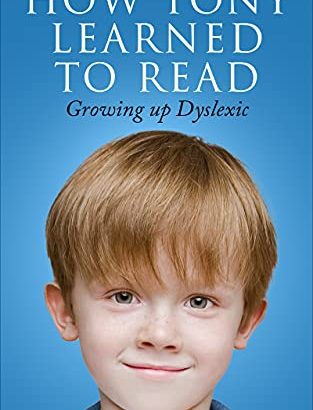Judge this book by its cover, not by its fonts
Opening How Tony Learned to Read: Growing Up Dyslexic, by Tony and Judy Fishel, was a bit of a shock. I was confronted with some paragraphs in large print Comic Sans. It was stunning since I expected another sober case study by a dyslexia researcher. I wondered what I had purchased!
A dyslexic-friendly book about dyslexia: what a concept!
The introduction quickly explained what I was seeing — different voices in different fonts. Judy (Tony’s mom) used a standard font and Tony used Comic Sans, a font that’s easier for him and many other dyslexic people to read. The different fonts made it easy to keep track of who was speaking. OK, I figured I could deal with that. After all, I’m always urging teachers to increase white space on pages and use fonts and sizes that dyslexic students find most comfortable.
So who is Tony?
Tony grew up in a close, attentive family. His mom, Judy, was a math and science educator in a wide variety of schools. Tony enjoyed a culturally rich childhood since his parents worked in the Philippines and the Marshall Islands when he was young. Tony had Judy’s constant help, good teachers, and three and a half years of dyslexia tutoring. BUT, he still couldn’t read. He managed school only by having Judy read everything to him.
I’ve known so many students like Tony — bright, curious, inventive, talented, and unable to learn to read with the tools provided at school and even in most private tutoring. That’s why Tony’s story gripped me. He is self-aware and simply eloquent as he relates what it feels like to be intellectually quick and curious but considered stupid by peers and teachers because he couldn’t read.
Tony taught himself to read
Thanks to a suggestion by his middle school special ed teacher, Tony discovered books on tape from the Library for the Blind. He got a recording of The Lord of the Rings, by J.R.R. Tolkien. Then he asked his parents for a printed copy of the books. When he had both, he began listening and tracking along visually with the reader. He went through the books several times. To his surprise, he taught himself to read!
At first, reading at a 3rd-grade level was a great improvement. But soon he discovered that this reading level wasn’t enough for high school, college, and graduate school. However, he didn’t progress any further. He was worried about teaching High School Physics if he couldn’t read the book.
Only after finishing graduate school, when trying to read books his uncle sent, struggling to read without the help of books on tape, did Tony begin reading at an adult level. Now he really had taught himself to read. As before, he desperately wanted to read these books and was surprised that he ended up able to read.
Apparently, reading the books four times each, always struggling alone, was what finally helped him learn to read at the level he desired.
Tony never gave up
Tony met daunting challenges and difficulties which would have made a weaker person give up. But he persevered, and finally got not only a BS in Physics but an MS in Education. He’s currently a physics teacher.
The pain and the glory of the dyslexic mind
I was so taken with Tony’s story, and with his mother’s perspective on the same incidents, that I contacted both Tony and Judy Fishel, and arranged to use quotes from the book and a video interview with Tony as part of the teacher training class I’ll be instructing next fall. This is a powerful story. It might change how you think about dyslexic students.
The important idea
This book illustrates the terrible price students pay when the education system is a poor fit for their learning needs. Over three years of phonics instruction in the “best” dyslexia program known to his teachers did nothing for him but frustrate him. No one ever taught him to track along with an audiobook, because no one knew what a powerful tool that is for dyslexic reading. Thankfully, he made that connection himself once he had books on tape.
I hope that Tony and Judy’s courage in sharing their story will help other students avoid the years of sadness and feeling stupid that Tony endured while his mom did her best to help him!
Read How Tony Learned to Read if you’re a teacher. It may change the way you teach. Read it if you’re a parent. It may change how you think about your dyslexic child.
Reviewed by Yvonna Graham, M.Ed.
@GrahamYvonna
To access free classic audiobooks, check out Librivox. For $15/mo Audible offers professionally read newer audiobooks (affiliate link) and many public libraries lend both paper and audiobooks.
